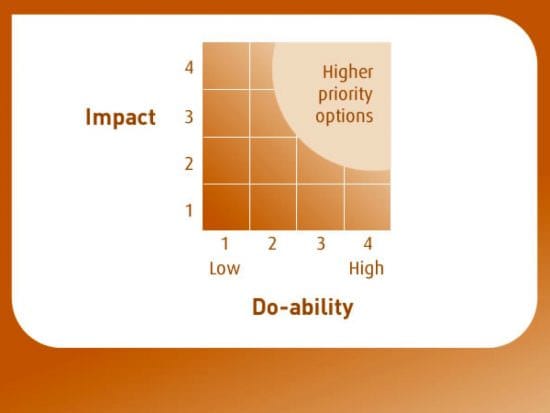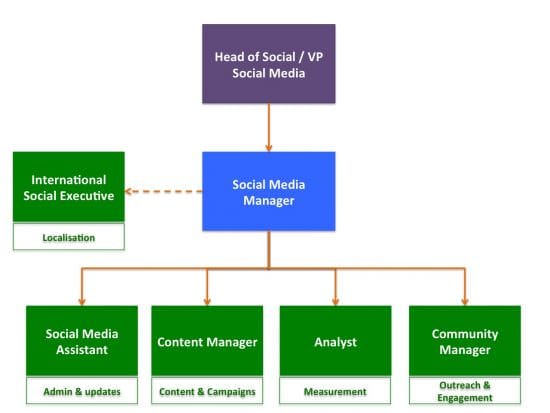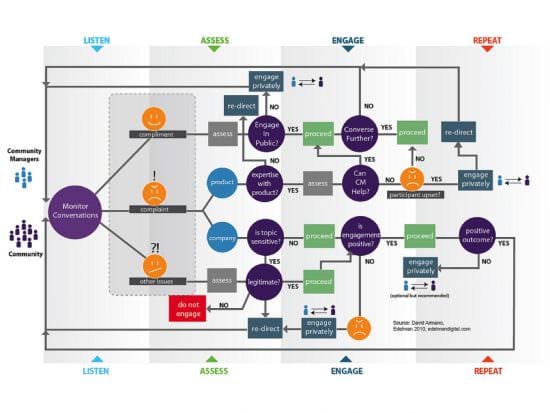Social media strategy and planning essentials series
This is part 7 of my Smart Insights 12 part social media series. In the last part we looked at aligning social media with other marketing channels; in this blog, I discuss what resources you need to manage your social media marketing and how you scale a social team sensibly.
To frame the conversation, you need to find answers to the following questions:
- How many people do you need and in which roles?
- What business processes are required?
- What KPIs should you use and what resources do you need to measure them?
- What tech and tools are required for your social media plan?
- How do these resource demands change in the next few years?
Approaches to resourcing
There are two main ways to plan your resourcing:
- Bottom up
You’re governed by the resource currently at your disposal, so you shape your scope of work around this. For example, if you only have a junior social media executive, you’ll need to focus them on the core day-to-day channel management rather than big strategic campaigns.
Although this is restrictive, it’s pragmatic if you don’t have budget to invest in more staff or external support. Don’t compromise your strategic vision but ensure your social media plan is realistic in terms of scale and frequency of activity.
- Top down
You define your social media strategy and then develop a resource plan that will help you deliver it. This mean matching skills and time to the strategy, and potentially demands recruitment or outsourcing elements to external specialists.
The advantage is that you don’t compromise on your scale of activity due to resource constraints; the challenge is getting the budget secured to plug skills gaps.
My preference is top down but I appreciate that some organisations can’t justify this, as they don’t have the budget. I’ve worked in startups where it’s very much ‘bottom up’, creating a strategy and then shaping the tactical delivery based on available resource and ensuring a focus on quality, not quantity.
Learning to prioritise
Finite resource = pragmatic approach.
There’s an almost infinite number of activities you can do via social media, especially when you consider how many networks there are and the tools that each provide.
If you try to do everything, you’ll dilute focus and compromise quality. So ensure you have a clear framework for prioritising actions:
- Have clear goals, target outcomes and success criteria
- Agree measurement criteria i.e. KPIs
- Align activities with these goals
- Evaluate customer and business benefit based on likely KPI impact
- Prioritise activities that add the most value
Here’s an example prioritisation matrix from the National College for Teaching & Leadership that can be applied to social media planning.

Allocating sufficient time to activities
If you’re new to social media marketing, take the time to plot how long each activity takes. You’ll be surprised at how long it can take to do simple things like post a tweet, if you’re focusing on quality and ensuring that each tweet adheres to quality and content guidelines. Yes, some updates are very quick but others take time to craft, adapt and fine tune so you’re making the most of the 140 characters.
Dull but essential
With limited resource, you need to work smartly which means optimising use of time.
If you know how long each activity takes, on average, you can plan work into your day and know you’ve got sufficient time to do things properly, not rush them. For each social post you need to decide:
- Who it’s aimed at
- Why would they be interested
- What do you want to tell them
- How do you need to tell it
- What content format best suits the message
- What CTA (if any) is required
- What’s the onward journey (if any) and does it provide a good UX?
For simple updates like company news, this is typically a few minutes work. However, for more challenging content such as responding to complaints or dealing with sensitive topics, social marketers typically take more time and craft social updates carefully. It’s easy to send the wrong message with a poorly composed update.
Linking social activity to roles & responsibilities
I find the best way to motivate people to take social media management seriously is to link outcomes with personal goals and objectives. This means social media success is linked to personal success, so you’re encouraging people to take ownership because performance is linked to reward.
Simply telling someone that ‘you need to post the updates on Twitter and Facebook’ with no relation to their core job description is a recipe for failure. Setting clear objectives and KPIs that are linked to PDRs and bonuses gives people a stake in the process.
Take away
Work with your HR to ensure that whoever is involved in social media marketing has the core requirements enshrined in their job description, with clear goals, objectives and KPIs.
And reward them for good performance.
Automating the basics to save time
Regardless of team size, it’s sensible to use tools & technology to speed up processes and reduce the manual workload. This helps your team focus on value-add work such as strategic campaigns, measurement, analysis and optimisation.
Examples of automation:
- Using Buffer to schedule and auto-post social updates
- Using Buzzsumo to run influencer research
- Setting up GA dashboards for social media metrics that email reports every day/week
- Using IFTTT recipes to trigger actions based on events g. if we get a new Twitter follower, send them a message
From my experience, playing with 3rd party tools is half the fun of social media. My warning is this – there are so many out there, be sure to have a clear set of requirements you want to satisfy before trialling, otherwise you’ll waste hours playing with fancy UIs but contribute nothing to your social media program.
Growing your social media team
Fingers crossed that all your planning efforts lead to great results from social campaigns and you have a business case to invest in more resource.
A sensible approach to scaling social media is to use a blended in-house/outsourced model. Initially you’re more dependent on external specialist skills, then overtime you skill up internally and scale down external investment. In the long-term, any agency/freelance support should be focused on strategy and helping you on-board new activities e.g. launch on a new social channel, develop and test an approach to messaging apps.
Below is a table of skills you should seek to build for the ultimate social media competency matrix.
| Skill type | Role | Summary |
| Admin | Social media executive | Responsible for day-to-day admin of social media channels & basic reporting. |
| Content marketing | Content Marketing Executive | Aligning social media channels with other marketing channels and creating content fit for purpose, customised for each audience. |
| International Social Media Executive | Customising and localising content for local social audiences. | |
| Strategy | Head of Social Media / Social Media Manager | Ownership of aligning social media with overall business strategy and goals. The champion for social media within the business. |
| Analysis & Optimisation | Web analyst | Implement a data driven approach to social media analysis & attribution modelling. |
| CRO Executive | Applying principles of CRO to social media marketing activity to help improve performance. | |
| Customer Service | Customer Service Assistant | Providing a rapid response and escalation channel for customer enquiries via social networks. |
Below is an example social team structure for a mature social media marketing team that has specialists for core roles and international capability to delivery localised campaigns and community management.

Each functional capability can be scaled depending on scope of activity e.g. as program expands, add more analysts to cope with increased measurement demands/complexity.
How would I build out a team?
I start with the core skills required to ensure that your social media presence is managed professionally. The bare minimum is to be able to respond to customers promptly and efficiently.
Please note I’m assuming there is a separate Customer Service team to fulfil the customer service assistant role.
- Social media executive (initially without a Head of Social Media, this person is managed by the Marketing Manager or Ecommerce Manager)
- Content marketing executive (without tailored content, you can’t grow your community or increase engagement)
- Social Media Manager (as you grow, you need a champion who can straddle strategy and execution)
- Web analyst (move you to a scientific approach to planning, analysis and optimisation)
- CRO Executive (help you fine tune your approach and improve key metrics)
- International social media exec (may be introduced earlier if dedicated profiles required in key international markets where local language skills essential).
Business processes
You need operational models to ensure your social media strategy can be implemented and is aligned with the overall business strategy.
For example, how do you integrate social media with your customer service framework to ensure social enquiries are effectively handled? This isn’t a one-size fit all approach; different models are in play:
- Dedicated customer service staff for handling social media enquiries
- Social enquiries routed into Customer Service via social media executive
The process can also be automated (based on a defined SLA e.g. first response within 30mins) or ad-hoc enquiry handling through a manual process.
Be sure to define your business processes and ensure all stakeholders have bought-in to this so it’s supported.
Common processes include:
- Publishing
- Responding
- Outreach
- Networking
- Monitoring
- Measuring & reporting
- Optimising
It helps to visualise business processes and user journey flows. Below is a good example from David Armano.

It’s not necessarily about hiring new people; it’s more about reconsidering what people do and how they support your social channel.
Your thoughts, comments and personal experience
So this is step 7 in the Smart Insights 12 step series on social media strategy and planning.
Did you find it useful?
How do you plan the resource for your social media activity? What skills are the most important to manage in-house, in your experience? Please do share tips and techniques to help others?
Please join in the discussion and share your experience in the comments field at the bottom of this page.
Keep an eye out for next month’s article, “Creating your social media reporting toolkit”.
Missed the previous articles? Catch-up here:
- 6 reasons why you need a social media strategy
- How to create a social media strategy and plan
- Using competitor analysis to inform social media plans
- Understanding the role of organic and paid social media
- Role of content marketing in social media
- Integrating social media with other marketing channels
Thanks
James
 Thanks to
Thanks to